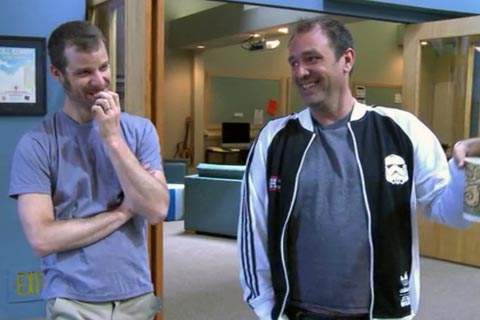

“6 Days to Air” Reveals “South Park”‘s Insane Production Schedule

I’ve always known that South Park is produced on an uncommonly fast production schedule, but I never realized how brutal that schedule is until I watched The Making of South Park: 6 Days to Air. The 42-minute documentary, which debuted last fall on Comedy Central, is currently available to view on Netflix streaming, which is where I saw it.
The bulk of the behind-the-scenes footage was filmed over the course of a week in April 2011 as Trey Parker and Matt Stone worked on the season 15 premiere episode “HumancentiPad.” Directed by Arthur Bradford, the film is filtered through the experiences of Parker and Stone, who lead the writing and production team through the show’s insane six-day production schedule, in which an entire half-hour episode is written, recorded, and animated entirely in Los Angeles. To put that into perpsective, most other animated TV shows have production cycles that last anywhere between 3 to 10 months, and are animated in far-flung studios halfway around the world. It’s understandable why South Park seasons are broken down into seven-week cycles because it’s hard to imagine them maintaining that pressure cooker environment for fourteen weeks in a row.
The production schedule, however, also plays a role in the show’s ability to remain timely and relevant in a way that few other animated shows could ever hope to be. In many ways, the pace of production–and resulting comedy–resembles live-action productions like Saturday Night Live, The Daily Show, and other late-night talkshows. Parker, who is the show’s primary writer, discussed how the discipline of a tight schedule prevented him from overthinking ideas:
“I always feel like, ‘Wow I wish I had another day with this show.’ That’s the reason that there’s so many episodes of South Park we’re able to get done because there just is a deadline and you can’t keep going. Because there’d be so many shows that I’m like, ‘No no it’s not ready yet, not ready,’ and I would have spent four weeks on one show. All you do is start second guessing yourself and rewriting stuff and it’s get overthought and it would have been 5 percent better.”
Also surprising was how creatively involved Parker and Stone remain in their creation. After sixteen seasons, they are still calling the shots, and they don’t appear to have surrendered their creativity to the big Hollywood machine. Compare that to a show like The Simpsons, which is run by a gaggle of writers and producers, and would probably roll along fine even if its creator Matt Groening ceased his involvement.
The documentary left me with some questions, too. For example, I had always considered Trey Parker and Matt Stone to be equal creative partners, but Bradford’s film portrays Parker as the captain of the ship. In fact, it’s never made implicity clear what Stone does while Parker is working on the script. Clearly, their collaboration works, but I would have liked to see their unique partnership explored further.

.png)